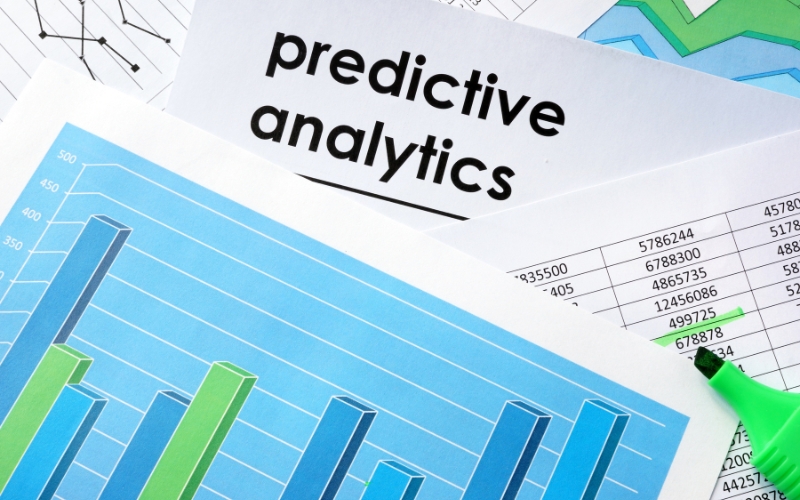
In today’s competitive marketing landscape, staying ahead of the curve requires making informed, data-driven decisions. This is where predictive analytics marketing comes into play. By utilizing statistical algorithms, machine learning, and historical data, businesses can forecast future customer behaviors, trends, and purchasing patterns. Predictive analytics marketing allows marketers to shift from reactive to proactive strategies, ensuring that campaigns resonate with the right audience at the right time. With its ability to enhance customer engagement and optimize marketing efforts, predictive analytics is quickly becoming an indispensable tool for businesses striving to improve their marketing outcomes.
Introduction to Predictive Analytics in Marketing

Predictive analytics marketing is transforming the way businesses approach decision-making, customer engagement, and marketing strategies. It involves the use of data, statistical algorithms, and machine learning techniques to analyze historical data and predict future trends. This powerful tool allows marketers to make smarter, data-driven decisions by forecasting customer behavior, identifying patterns, and improving targeting efforts.
At its core, predictive analytics marketing combines vast amounts of data from various sources, such as customer transactions, website interactions, and social media behavior, to create predictive models. These models are designed to forecast future customer actions, such as purchasing decisions, content preferences, and even churn likelihood. By understanding these insights, marketers can craft personalized campaigns that resonate with their audience, leading to better engagement and higher conversion rates.
One of the most important aspects of predictive analytics marketing is its ability to offer a proactive approach to marketing. Instead of reacting to customer behavior after the fact, businesses can anticipate their customers’ needs and preferences. For instance, if the predictive model forecasts that a segment of customers is likely to make a purchase within the next month, marketers can tailor campaigns to target these customers with specific offers, ensuring a more timely and relevant interaction.
The role of machine learning in predictive analytics marketing is also crucial. Through continuous learning from new data, machine learning algorithms refine the predictions they make, increasing their accuracy over time. As businesses accumulate more data and insights, their predictive models improve, allowing for even more precise forecasting. This enables marketers to shift from generalized strategies to hyper-targeted, individualized campaigns that can significantly increase ROI.
Predictive analytics marketing has become a game-changer for companies aiming to stay ahead of the competition in a fast-paced digital environment. By leveraging the power of predictive models, businesses can not only predict customer behavior but also act on those predictions to optimize marketing efforts. This leads to more efficient resource allocation, higher customer satisfaction, and ultimately, increased sales and revenue.
Understanding Key Data Sources for Predictive Analytics Marketing

In the world of predictive analytics marketing, data is the foundation upon which businesses can build more effective and targeted strategies. By leveraging various data sources, businesses can predict customer behaviors, trends, and market shifts with greater accuracy. The key to effective predictive analytics marketing lies in the ability to gather, process, and analyze different types of data, which ultimately leads to smarter marketing decisions.
One of the primary data sources used in predictive analytics marketing is customer data. This includes demographic information, purchasing history, customer preferences, and feedback. By understanding customers’ past interactions with a brand, businesses can predict future behavior, such as the likelihood of making a purchase or responding to a specific marketing campaign. This data helps marketers segment customers more effectively, allowing for the creation of personalized offers that resonate with each segment’s unique characteristics.
Another critical data source is historical marketing data. This encompasses past campaign performance, including click-through rates, conversion rates, customer engagement levels, and sales results. By analyzing this data, marketers can uncover patterns in customer behavior and identify which strategies have been successful in the past. Predictive analytics marketing uses this historical information to forecast the effectiveness of future campaigns, optimizing the allocation of resources and budget. For instance, if a certain type of email campaign led to higher engagement in the past, the predictive model can recommend similar approaches in future marketing efforts.
Online behavior data is also a crucial element in predictive analytics marketing. This includes data collected from customers’ interactions on websites, social media platforms, and mobile apps. Tracking metrics such as browsing behavior, search queries, time spent on a page, and social media engagement helps businesses understand how customers are engaging with their brand. This real-time data allows predictive models to make immediate forecasts about potential customer actions, ensuring marketing campaigns are timely and relevant. For example, if a customer spends time viewing a specific product on a website, predictive analytics marketing can trigger an automated email or display an ad to encourage them to complete their purchase.
Incorporating all these data sources into a predictive analytics marketing strategy enables businesses to make informed decisions and tailor their marketing efforts based on accurate predictions. By continuously gathering and analyzing customer, historical, and behavioral data, companies can stay ahead of the curve, providing customers with the right messages at the right time. This data-driven approach not only increases marketing effectiveness but also enhances customer satisfaction and loyalty.
How Predictive Analytics Enhances Customer Segmentation

Customer segmentation is a critical aspect of any successful marketing strategy, and predictive analytics marketing plays a pivotal role in enhancing this process. Traditionally, customer segmentation was based on broad demographics, but with the power of predictive analytics, businesses can now create much more precise and effective segments based on deeper insights into customer behavior and preferences.
Predictive analytics marketing helps businesses move beyond the basic segmentation criteria by incorporating a variety of data points, such as purchase history, online behavior, and interaction with previous campaigns. By analyzing these data points, predictive models can identify patterns and predict future actions, allowing marketers to create highly targeted segments that are more reflective of customers’ likely behavior. For instance, predictive analytics can help identify high-value customers who are likely to make repeat purchases or those who are at risk of churning. This enables businesses to take proactive measures, such as offering loyalty rewards or personalized content, to retain their most valuable customers.
One of the key benefits of predictive analytics marketing is its ability to improve the accuracy of segmentation. By leveraging advanced algorithms and machine learning, predictive models can analyze vast amounts of data quickly and efficiently, uncovering nuanced patterns that would be difficult for marketers to spot manually. For example, predictive analytics can reveal that a group of customers who previously purchased a specific product are more likely to purchase an accessory related to that product. By recognizing such trends, businesses can develop targeted campaigns that offer these accessories, leading to higher conversion rates and increased sales.
Personalized marketing efforts driven by predictive insights are more likely to resonate with customers, as they feel the brand understands their unique needs and preferences. Predictive analytics marketing allows for the creation of tailored messages, offers, and recommendations that speak directly to each segment’s behaviors, increasing engagement and fostering stronger customer relationships. This level of personalization not only boosts customer satisfaction but also enhances brand loyalty, as customers are more likely to engage with a brand that caters to their individual needs.
Predictive Analytics and Campaign Optimization

Predictive analytics marketing has revolutionized the way businesses approach campaign optimization. With the vast amount of data available today, marketers are increasingly turning to predictive analytics to guide their decisions, refine strategies, and enhance marketing outcomes. By leveraging predictive models, businesses can optimize various aspects of their marketing campaigns, from A/B testing to budget allocation, ensuring that every dollar spent contributes to higher returns on investment (ROI).
One of the primary ways predictive analytics marketing can optimize campaigns is through A/B testing. Traditionally, A/B testing involves comparing two variations of an ad, email, or landing page to see which one performs better. Predictive analytics takes this process a step further by using historical data and machine learning algorithms to forecast which variation is more likely to succeed with specific audience segments. For example, by analyzing past engagement and conversion rates, predictive models can suggest the best content, design, or call-to-action that will resonate with customers. This data-driven approach reduces the guesswork in A/B testing and helps marketers quickly identify the most effective options, leading to more efficient campaign optimization.
Another key area where predictive analytics marketing plays a critical role is in budget optimization. With predictive models, marketers can forecast the potential ROI of different campaign strategies, helping them allocate resources more effectively. By analyzing customer data, engagement patterns, and past campaign performance, predictive analytics can predict which channels or tactics are likely to yield the best results. This allows businesses to adjust their budgets in real time, prioritizing high-performing strategies and avoiding unnecessary spend on underperforming ones. As a result, companies can maximize their marketing spend, ensuring that every dollar is used in the most effective way to generate the highest returns.
Additionally, predictive analytics marketing can improve customer targeting and personalization. By analyzing customer behavior, predictive models help marketers identify the right audience for each campaign. Whether it’s predicting which customers are most likely to respond to a specific promotion or anticipating the needs of a segment before they make a purchase, predictive analytics ensures that campaigns are personalized to the right individuals at the right time. This not only boosts engagement but also enhances customer experience, driving higher conversion rates and customer loyalty.
Overcoming Challenges in Implementing Predictive Analytics Marketing

While predictive analytics marketing offers significant benefits in driving smarter decisions and optimizing campaigns, businesses often face challenges when implementing these powerful tools. Understanding these obstacles and how to address them is key to making predictive analytics accessible and effective for companies of all sizes.
One of the most common challenges in implementing predictive analytics marketing is data quality. Predictive models rely heavily on clean, accurate, and comprehensive data to generate meaningful insights. However, businesses often struggle with incomplete or inaccurate data, which can skew the predictions made by analytics models. To overcome this, businesses must invest in data cleaning and management practices. Ensuring that data is collected from reliable sources, regularly updated, and processed for consistency can dramatically improve the effectiveness of predictive analytics marketing. Additionally, using data validation techniques and automated tools can help identify and correct errors before they impact the models.
Another significant barrier is technological limitations. Implementing predictive analytics marketing often requires advanced tools, platforms, and infrastructure that some companies may lack, especially smaller businesses with limited budgets. Investing in scalable predictive analytics software solutions can help mitigate this issue. Cloud-based analytics platforms are a cost-effective option, offering businesses access to sophisticated analytics tools without the need for expensive on-premise infrastructure. These platforms also offer the flexibility to scale up as businesses grow, ensuring that companies can take advantage of predictive analytics regardless of their size or technological resources.
The need for specialized skills also presents a challenge for many organizations. Predictive analytics marketing involves a combination of data science, statistical analysis, and machine learning, all of which require expertise that may not be available in-house. To address this gap, businesses can consider partnering with external experts or investing in employee training to build in-house capabilities. Another solution is to adopt user-friendly predictive analytics tools designed for marketers, which offer simplified interfaces and templates that do not require advanced technical knowledge to operate. This allows marketing teams to harness the power of predictive analytics marketing without needing to become data scientists.
Finally, businesses often face resistance to change from employees who may be accustomed to traditional marketing methods. To overcome this, companies should invest in change management strategies, ensuring that all team members understand the value of predictive analytics marketing. Offering training sessions, clear communication about the benefits, and a gradual integration of predictive analytics into existing workflows can help employees embrace these new tools.
Conclusion
To further explore the transformative power of predictive analytics in marketing, it’s essential to stay updated on the latest trends and tools. For example, platforms like HubSpot provide in-depth resources on how predictive analytics can be integrated into your marketing strategies to boost customer engagement and ROI. By utilizing such platforms, businesses can access helpful tools and insights that make predictive marketing more actionable and effective.
In conclusion, predictive analytics marketing is transforming how businesses approach their marketing strategies, offering the ability to predict customer behavior, improve segmentation, and optimize campaigns for better performance. By leveraging accurate data insights, companies can make smarter, more targeted decisions that lead to higher engagement and increased revenue. While implementing predictive analytics marketing can come with challenges such as data quality and technological limitations, the benefits far outweigh the obstacles. As more businesses embrace this powerful tool, predictive analytics will continue to reshape the future of marketing, enabling companies to stay competitive and deliver more personalized experiences to their customers.
For more details or to discuss your specific Marketing requirements, visit our AI Scope Digital page.

